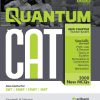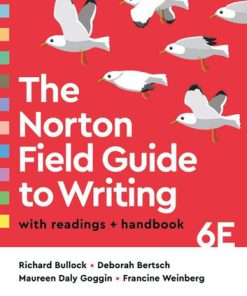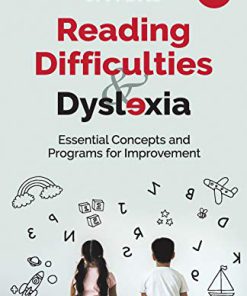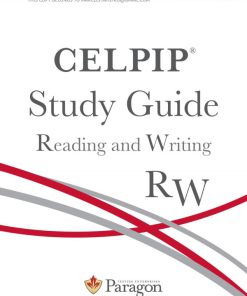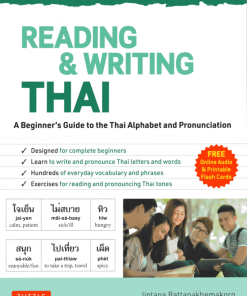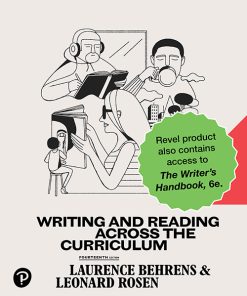Assessing and Correcting Reading and Writing Difficulties 6th Edition by Thomas Gunning ISBN 9780134516622 0134516621
$50.00 Original price was: $50.00.$25.00Current price is: $25.00.
Assessing and Correcting Reading and Writing Difficulties 6th Edition by Thomas Gunning – Ebook PDF Instant Download/Delivery: 9780134516622 ,0134516621
Full download Assessing and Correcting Reading and Writing Difficulties 6th Edition after payment
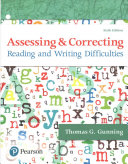
Product details:
ISBN 10: 0134516621
ISBN 13: 9780134516622
Author: Thomas Gunning
Assessing and Correcting Reading and Writing Difficulties 6th Edition Table of contents:
1 Introduction to Literacy Difficulties
Using What You Know
Anticipation Guide
The Nature of Reading Difficulties
A New Approach to Identifying Reading Disability
Clarifying the Discrepancy Concept
Functional Definition
Delayed or Disabled
Incidence of Reading Problems
Persistence of Severe Problems
English Language Learners as Struggling Readers
The Nature of Intervention and Corrective Instruction
Part-to-Whole Approach
Whole-to-Part Approach
An Interactive View
Impact of Literacy Difficulties
Principles of Intervention and Corrective Instruction
Prevention versus Correction
Importance of Success
Building on the Known
Fostering Independence
Personalized Instruction
Continuous Assessment and Progress Monitoring
A Full Range of Literacy Experiences
Direct, Systematic Instruction
An Integrated Approach
Wide Reading
The Role of Deliberate Practice
Providing Materials at the Appropriate Challenge Level
A Sense of Community
Using an RTI Approach
Impact of Federal Legislation and Standards
Individuals with Disabilities Education Improvement Act (IDEIA)
The Whys of Reading Problems
Summary
Key Terms
Application Activities
2 Factors Involved in Reading and Writing Difficulties
Using What You Know
Anticipation Guide
Interacting Factors in Reading and Writing Difficulty
Cognitive Factors
Overall Cognitive Ability
Memory
Helping Students Who Have Reduced Working Memory
Associative Learning
Attention
Language Factors
Articulation Difficulties
Phonological Factors
Rapid Automatized Naming
Word-Finding Problems
Compensatory Programming
Orthographic Processing
Affective Factors
Developing a Sense of Self-Efficacy
Lack of Positive Identity as a Reader
Executive Functioning and Self-Regulation
Helping Students Overcome Negative Behaviors
Physical Causes
Neurological Factors
Hearing Impairments
Degree of Physical Loss
Extent of Impairment
The Reading Teacher’s Role
High-Frequency Loss
Use of Frequency Modulated Systems
Vision Impairments
Accommodation and Convergence
The Special Case of Amblyopia
Color Vision
Screening Vision
The Role of the Reading Specialist
Visual Processing Deficits
Reversals
Delayed or Faulty Directionality
Vision Training (Vision Therapy)
Physical Health
Social, Cultural, Economic, and Educational Factors
Family Factors
Economic Factors
Educational Factors
Scientifically Based Instruction
Summary
Key Terms
Application Activities
3 Overview of Assessment
Using What You Know
Anticipation Guide
Principles of Effective Assessment
Interactive Assessment
Multidimensional Assessment
Realistic Assessment
Dynamic Assessment
Administering a Dynamic Assessment
Assisted Testing
Levels of Knowledge
Trial Teaching
Tests
Norm-Referenced Tests
The Meaning of Norm Scores
Purpose of Norm-Referenced Tests
Criterion-Referenced Tests
Survey versus Diagnostic Tools
Formal versus Informal Tests
Screening versus Monitoring
Formative versus Summative Assessment
Assessing for Learning
Evaluating Assessment Devices
Reliability
Validity
Standard Error of Measurement
Usefulness
Fairness
Functional-Level Assessment
Computer Adaptive Testing
High-Stakes Tests
Measuring Growth
Reporting Test Results to Parents
Assessing English Language Learners
Summary
Key Terms
Application Activities
4 Placing Students and Monitoring Progress
Using What You Know
Anticipation Guide
The Informal Reading Inventory
The IRI as a Placement Device
Administering the Word-List Tests
Interpreting the Results of the Word-List Tests
Assisted Testing
Administering the IRI Passages
Preparation for Reading a Passage
Comprehension Check
Administering Silent-Reading Passages
Oral Rereading
Rate of Reading
Reaching the Frustration Level
Establishing Listening Capacity
Interpreting Inventory Results
Word Recognition
Comprehension
Supplementary Questions
Shortcomings of IRIs
Selecting an IRI
Miscue Analysis
Adapted Miscue Analysis
Running Records
Analyzing Miscues in a Running Record
Commercial Running Records
Planning Instruction Based on IRI, Miscue Analysis, or Running Record Results
IRI-Based Tests
Oral-Reading Tests
Word-List Tests
Group Inventories
Degrees of Reading Power (DRP)
The Scholastic Reading Inventory and i-Ready™ Diagnostic & Instruction
Screening, Monitoring Progress, and Benchmarking
Curriculum-Based Measures
Emergent and Early Reading CBMs
Letter Name Fluency
First Sound Fluency (DIBELS Next)
Letter Sound Fluency
Phoneme Segmentation Fluency (DIBELS)
Word Identification Fluency
Fluency and Comprehension CBMs
Oral-Reading Fluency
Maze Passages
IRIs and Running Records
Setting Benchmarks
Constructing a Screening or Progress-Monitoring Assessment
Progress Monitoring Portfolio
Mini–Case Study
Summary
Key Terms
Application Activities
5 Assessment of Reading and Writing Processes
Using What You Know
Anticipation Guide
Reading Processes: Decoding
Published Phonics Tests
Reading Processes: Comprehension and Study Skills
Retelling
Think-Alouds
Mystery Passages Think-Aloud
Administering a Mystery Passage as a Diagnostic Instrument
Analyzing Students’ Performance on Mystery Passages
Importance of Probing Responses
Interviews and Questionnaires
Observations
Anecdotal Records
Background Knowledge
Assessing Study Skills
Assessing Vocabulary Knowledge
Assessing Writing
Role of Students
Assessment Techniques
Observations
Journals
Using Rubrics to Evaluate Writing
Using Portfolios to Assess Writing and Other Literacy Skills
Steps in Using Portfolios
Assessing Writing Samples
Commercial Tests of Writing
Spelling and Handwriting
Stages of Spelling
Prephonemic
Alphabetic
Word Pattern
Syllabic
Morphemic
Determining the Stage of Spelling
Commercial Spelling Tests
Handwriting
Summary
Key Terms
Application Activities
6 Assessment of Cognitive, School, and Home Factors
Using What You Know
Anticipation Guide
Assessment of Capacity
Role of Intelligence Tests
Wechsler Scales
Verbal Comprehension
Similarities
Vocabulary
Comprehension
Information
Visual-Spatial
Block Design
Visual Puzzles
Fluid Reasoning
Matrix Reasoning
Figure Weights
Picture Concepts
Arithmetic
Working Memory
Digit Span
Picture Span
Letter–Number Sequencing
Processing Speed
Coding
Symbol Search
Cancellation
Ancillary Subtests
Naming Speed—Literacy
Naming Speed—Quantity
Symbol Translation
Stanford-Binet
Peabody Picture Vocabulary Test
Woodcock-Johnson IV Test of Cognitive Abilities (Houghton Mifflin Harcourt)
Detroit Tests of Learning Aptitude, 4th Edition (Pro-Ed)
Detroit Tests of Learning Aptitude—Primary, 3rd Edition (DTLA-P-3) (Pro-Ed)
Kaufman Assessment Battery for Children II (Pearson)
Group Intelligence Tests
Tests of Listening, Language, Memory, Associative Learning, and Word Finding
Listening
Tests of Language
Assessment of Memory
Associative Word Learning
Word Finding
Assessing the Instructional Situation
Functional Assessment of Academic Behavior
Benchmark School Interactive Learner Profile
School Records
Case History
Students’ Views
Reading Expectancy
Summarizing, Organizing, Interpreting, and Reporting Assessment Data
Making Recommendations
Professional Reports
Assessment: An Ongoing Process
A Multidisciplinary Approach
Mini–Case Study
Summary
Key Terms
Application Activities
7 Emergent Literacy and Prevention Programs
Using What You Know
Anticipation Guide
Emergent Literacy and Prevention Programs
Prevention Programs
Fostering Emergent Literacy
Using Read-Alouds and Writing to Develop Emergent Literacy
Selecting Read-Alouds
Dialogic Reading
Developing Concepts about Print
Informal Assessment of Concepts of Print
Writing Sample
Developing Concepts of Print
Shared Reading
Concept of Separate Words
Focused Shared Reading
Students’ Writing
Shadow Writing
Using Invented Spelling
Language-Experience Approach
Shared Writing
Individual Interactive Writing
Handwriting
Phonological Processes and Reading
Phonological Awareness and English Language Learners
Assessing Phonological Awareness
Rhyming
Beginning Sounds
Blending
Segmentation Ability
Manipulating Sounds
Commercial Tests
Techniques for Building Phonological Skills
Rhyme
Blending
Segmentation
Elkonin Technique
Say-It-and-Move-It
Beginning Sounds
Sorting Beginning Sounds
Other Activities
Playing with Sounds
A Reciprocal Relationship
Phonological Awareness and Word Analysis
Programs for Teaching Phonological Awareness
Fundations, 2nd Ed. (Wilson)
Phonemic Awareness in Young Children: A Classroom Curriculum (Brookes)
Word Study
Road to the Code (Brookes)
Letter Knowledge
Assessing Letter Name Knowledge
Teaching Letter Names
Invented Spelling
Using Technology
Using Periodicals
Mini–Case Study
Prekindergarten Prevention Programs
Creative Curriculum (Teaching Strategies)
Get Ready to Read
High Scope
Ladders to Literacy: A Preschool Curriculum, Second Edition (Brookes)
Literacy Express (Lakeshore)
Opening the World of Learning (OWL; Pearson School)
Para Los Niños
Webbing into Literacy
Early Childhood Educators’ Position on Literacy Instruction
Summary
Key Terms
Application Activities
8 Teaching Phonics, High-Frequency Words, and Fluency
Using What You Know
Anticipation Guide
Phonics and the Struggling Reader
Example of Decoding Difficulty
Types of Word-Recognition Difficulty
Deficient Decoders
Disabled Decoders
Inaccurate Decoders
Nonautomatic Decoders
Incidence of Deficient Decoding among Older Students
A Theory of Decoding
How Words are Read
Phases in Learning to Read Words
Prealphabetic Phase
Alphabetic Phase
Consolidated Alphabetic Phase
Syllabic and Morphemic Phase
Principles of Teaching Phonics to Struggling Readers
Differentiation of Phonics Instruction
The Role of Dialect in Teaching Phonics
Teaching Consonants
Approaches to Teaching Consonants
Other Consonant Elements
Consonant Digraphs
Final Consonants
Consonant Blends (Clusters)
Confusing Consonants
Sequence of Teaching Consonants
Reinforcement Activities for Consonant Correspondences
Reading
Sorting
Additional Reinforcement Activities
Using a Multisensory Approach to Learn Letter Names and Letter Sounds
Teaching Vowels
Vowel Generalizations
Short Vowels
Open Syllables
Final-e Markers
Unstressed Syllables
Digraphs
Variability in Vowels
The Role of Phonological Processing in Teaching Vowel Correspondences
Word-Building Approach to Teaching Vowel Correspondences and Patterns
Preparation for Introducing Short-Vowel Words in a Word-Building Approach
Adjusting Instruction
Using a Sound-by-Sound Approach
Integrating Syllabic Analysis with Basic Phonics
Introducing Long-Vowel Patterns
Final-e Words
Vowel Digraphs
Make-and-Break Technique for Introducing or Reviewing Patterns
Whole–Part–Whole Approaches
Sequence for Teaching Vowels
Application of Phonics Skills
Application Through Reading
Leveling Books According to the Decoding Skills Needed to Read Them
Additional Reinforcement for Vowel Patterns
Sorting
Modified Bingo
Modified Concentration
Little Books
Using Writing to Reinforce Phonics
Assembling Words
Word Wall
Secret Word
Making Words
Building Words
Poems and Verses
Technology
Digital Programs
Explode the Code Online
iRead (Scholastic)
Phonics Progress Monitoring
Mini–Case Study
Word-Analysis Strategies
Pronounceable Word-Part Strategy
Analogy Strategy
Decoding Strategy
Context Strategy
Advanced Strategies
Prompting Strategy Use
How to Figure Out Hard Words
Balanced Use of Decoding Strategies
Using Prompts to Foster the Use of Balanced Decoding Strategies
Fostering Self-Correction
Effective Use of Strategies
When Students Overuse Phonics Cues
When Students Overuse Context Clues
Mini–Case Study
A Means to an End
High-Frequency Words
How High-Frequency Words Are Learned
Orthographic Processing and Learning High-Frequency Words
High Payoff of High-Frequency Words
Direct Teaching Approach for High-Frequency Words
Alternate Presentation for Students in the Alphabetic Stage
Indirect Teaching Techniques for Learning High-Frequency Words
Shared Reading
Singing High-Frequency Words
Language-Experience Stories
Exemplary Teaching: Balancing Decodable Text with Predictable Books
Additional Practice Activities for High-Frequency Words
Words on the Wall
Sight-Word Commands
Pantomime
Read the Label
Forming Phrases and Sentences
Sorting
Fostering Fluency
Repeated Reading
Variations on Repeated Reading
Predictable Books
Wide Reading
Silent Reading
Recorded Reading
Reading to Others
Buddy Reading
Choral Reading
Paired Reading
Echo Reading
Alternate Reading
Performance Reading
Reader’s Theater
Increasing the Amount of Reading
Putting Fluency in Perspective
Mini–Case Study
Summary
Key Terms
Application Activities
9 Syllabic, Morphemic, and Contextual Analysis and Dictionary Strategies
Using What You Know
Anticipation Guide
Syllabic Analysis
Approaches to Teaching Syllabic Analysis
Generalization Approach to Syllabication
Pattern Approach to Syllabication
Reading by Syllables and Whole Words
Spelling by Syllables
Syllables in Isolation
Pronounceable Word-Part and Analogy Strategies Applied to Polysyllabic Words
Teaching the Strategies
Generalization Approach to Decoding Polysyllabic Words
Implementing a Systematic Program
Additional Syllabic Analysis Programs
Megawords
Rewards
SIPPS
System 44
Word Work Program
Morphemic Analysis
Teaching Morphemic Elements
Making Connections
Prefixes
Suffixes
Roots
Morphological Analysis Word Mapping Strategy
Attacking Words That Have Multiple Parts
Contextual Analysis
A Complex Process
Steps for Using Context
Types of Context Clues
Definition
Synonyms
Comparison–Contrast
Function Indicators
Example
Experience
Pictorial Clues
Combined Morphological and Semantic Clues
Using the Dictionary
Teaching Dictionary Skills
Deriving Correct Meanings
Determining the Correct Pronunciation
Glossaries
A Functional Tool
Balanced Use of Strategies
Using Think-Alouds
Mini–Case Study
Summary
Key Terms
Application Activities
People also search for Assessing and Correcting Reading and Writing Difficulties 6th Edition:
tc reading and writing assessments
reading and writing assessment test
understanding assessing and teaching reading
understanding assessing and teaching reading a diagnostic approach
virginia reading and writing assessment
Tags: Thomas Gunning, Assessing, Correcting Reading, Writing Difficulties
You may also like…
Education Studies & Teaching - Special Education
Uncategorized
Moving Home Gender Place and Travel Writing in the Early Black Atlantic 1st Edition Sandra Gunning
Education Studies & Teaching - Teaching - Reading & Language
Reading and writing THAI 1st Edition by Jintana Rattanakhemakorn ISBN 9780804853798 0804853797
Reference - Writing
Writing and Reading Across the Curriculum (Fourteenth Edition) Laurence Behrens
Education Studies & Teaching - Special Education
Uncategorized
Business and Technical Writing 6th Edition by Jeffrey Jablonski 1465289283 978-1465289285

